Elizabeth Andrews's Blog, page 10
October 10, 2017
October is the month for making potions...
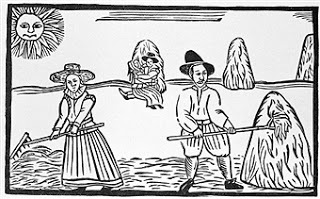
The month of harvest and falling leaves is the ideal time to make sympathetic and magical potions for the treatment of wounds; these as tradition dictates are applied to the weapon that makes the wound instead of the wound itself.
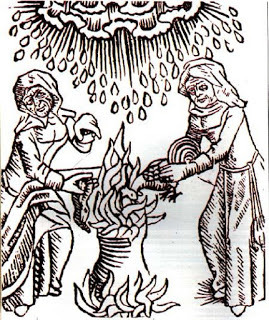
"Take the moss on the skull of a strangled man two ounces; of the mummia of man's blood an ounce and a half; of earthworms washed in wine or water an ounce and a half; of the hemetitis two ounces; of the fat of a boar and a boar pig, two drams each; oil of turpentine two drams. Pound them and keep them in a narrow pot and make this cure when the sun is in Libra. Dip into the ointment the iron or wood of the weapon, or if the weapon cannot be had a sallow stick made wet with blood in opening the wound. And let the patient wash his wound in the morning with his own urine and bind it with a clean cloth, always wiping away the matter."
Excerpt from the Fairfax Household Book, 17th/18th century.
Published on October 10, 2017 07:01
September 26, 2017
Blackberries and Holy Rood Day
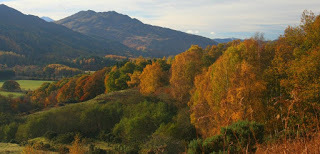
Now is the time to pick blackberries before the Devil fouls them. In Scotland it is on the Old Style Holy Rood Day that he poisons the brambles by either spitting or urinating on them.
'Oh Weans! Oh Weans! the morn's the FairYe may na eat the berries mairThis nicht the Devil gangs ower them a'To touch them with his pooshioned paw'
In England he does not foul the berries until Old Michaelmas ( 10th Oct)
Holy Rood Day which is known as Mid Autumn in the Highlands of Scotland is traditionally the beginning of the mating season for deer. It is also traditional at this time for young women to gather St Michaels wild carrot; forked roots were especially lucky, tied into bunches they were presented to male visitors on Michaelmas Day.The carrots had to be gathered in a certain way, first by digging a triangular hole around the plant, signifying St Michael's shield, using a three pronged mattock which signified St Michael's trident.
'Cleft, fruitful, fruitful, fruitful,Joy of carrots surpassing upon me,Michael the brave endowing meBride the fair be aiding me'
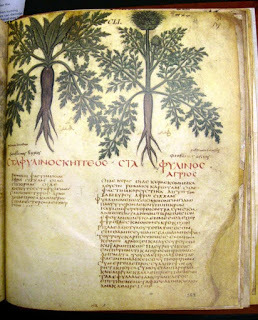
Published on September 26, 2017 05:20
September 22, 2017
Witch Balls
The term 'scrying' comes from the English word descry which means to make out dimly or to reveal. A typical scryer was a wise woman, gifted with second sight, and often referred to as a witch. This ability is not limited to using crystal balls, any reflective surface will do. The favoured speculum is the magic mirror, preferably one with a concave side painted black.Few witches throughout the ages would have used crystal balls for scrying, being too heavy and expensive, instead the more easily available glass fishing floats were commonly used, especially in England.
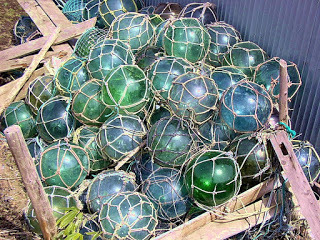
Perhaps this is why sailors have such a strong belief in the power of witches, believing them to have power over men’s fate out at sea, referring to them specifically as sea witches. These sea witches were believed to haunt the coast lines around the country, cursing the sailors and willing the ships to wreck upon the rocks. Some believe that these particular creatures are the ghosts of dead witches and it was one of these ghostly sea witches that was, according to legend, sent by the Devil to assist Sir Francis Drake in his battle against the Spanish Armada This phantom helped him raise a storm at sea and defeat the fleet. In return for this it was said that Drake bartered his soul to Old Nick.
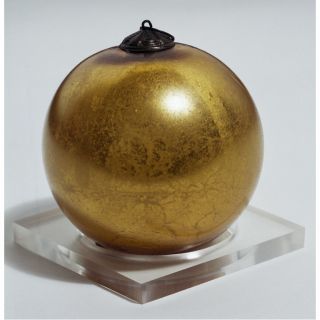
Coloured glass balls often referred to as Witch Balls had another use, they were hung in windows of dwellings and intended to keep out witches and the evil eye.These ,made from the 17th century onwards, would hopefully deflect curses and ill wishing. The bright colours of the glass was supposed to entice the evil spirits into the ball and then trap it forever in the salt or Holy water that had been placed inside. And by keeping one of these balls in your home it would prevent a witch from entering as traditionally witches supposedly do not have a reflection or can not bear to see their own reflection.
This tradition travelled across the pond to America in the 19th century.Although in other parts of America especially the Ozarks a witch ball had another form and use. It would be made from black hair rolled in beeswax to form a hard marble shaped lump. This is not for protection this would be used by somebody, presumably a witch ,to harm or curse a victim. It is said in this area that one of these witch balls would always be found near the body of somebody killed by this curse.
The hanging of the protective witch balls in our homes continues today, the glass baubles on the Christmas tree originate from this practice. The use of these are supposed to deflect any envious thoughts when seeing the huge stacks of pressies under the tree!
Published on September 22, 2017 04:30
September 21, 2017
St Mathews Day
Darker evenings and cooler weather now beginning...

"St Mathew, get candle newSt MathewBrings the cold rain and dewbutMathew's Day bright and clearBrings good wine in next year"
Published on September 21, 2017 06:52
September 18, 2017
Toad Doctor
The name Toad Doctor summons up the image of an expert in amphibian diseases but in earlier years it would have meant something completely different.
While wise women and pellars would have utilised the so called magical properties of the toad it was only the Toad Doctor who exclusively used this amphibian for cures.

Toad cures first made an appearance during Roman times and were given cooked in salt and oil as an antidote for snake bite. Toads were also used as a cure for bed wetting; the amphibian would be tied between the legs of the child just before going to bed. If they started to urinate it was thought that the toad would start to croak and so wake the sleeper. It continued to be an important ingredient in folk magic for many centuries, and it was during the 17th and 18th century that saw a marked growth in the popularity of this folk medicine. A ritual known as the toad bone rite became popular, particularly in East Anglia but also in other areas of the country, amongst both cunning folk and members of magical organizations such as the Scottish Society of the Horseman's Word and East Anglian Society of Horsemen. Although there were many variations, the ritual typically involved the killing of a toad or frog, having its flesh stripped from the bones by ants, and then throwing the bone into a stream at night. It was believed that this would grant the practitioner, who was known as a Toad Man, the ability to perform certain magical tasks.Toad Doctors were found mainly in the south west of England and they would travel from town to town peddling their cures. The most common ailment that they treated was scrofula, otherwise known as the kings evil.
This is an infection of the lymph nodes, resulting in large swellings on the face and neck. A bag containing toad legs would be placed around the patients neck which they would have to wear until the legs decayed by which time it was believed that the cure would have been effective.
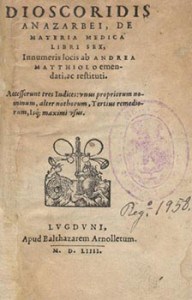
The most well documented Toad Doctor was John Buckland of Dorset who described himself as a surgeon in the 1841 census. With his family he would hold an annual Toad Fair at the beginning of May at Stalbridge in Dorset. Crowds of people would travel to see him, all carrying their toads. He would then rip the legs off of the creatures and place them still twitching in bags, and put them around the patients neck. The reported price for this treatment was the exorbitant seven shillings per bag.
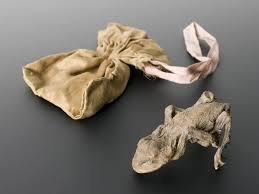
Toad powder was prescribed for urinary problems as it was believed to be a diuretic, and for any complaints that caused swellings, inflammations or growths. Toad bones and toad skins were also given to prevent plague and small pox.
Thankfully these traditional remedies are a thing of the past.
While wise women and pellars would have utilised the so called magical properties of the toad it was only the Toad Doctor who exclusively used this amphibian for cures.

Toad cures first made an appearance during Roman times and were given cooked in salt and oil as an antidote for snake bite. Toads were also used as a cure for bed wetting; the amphibian would be tied between the legs of the child just before going to bed. If they started to urinate it was thought that the toad would start to croak and so wake the sleeper. It continued to be an important ingredient in folk magic for many centuries, and it was during the 17th and 18th century that saw a marked growth in the popularity of this folk medicine. A ritual known as the toad bone rite became popular, particularly in East Anglia but also in other areas of the country, amongst both cunning folk and members of magical organizations such as the Scottish Society of the Horseman's Word and East Anglian Society of Horsemen. Although there were many variations, the ritual typically involved the killing of a toad or frog, having its flesh stripped from the bones by ants, and then throwing the bone into a stream at night. It was believed that this would grant the practitioner, who was known as a Toad Man, the ability to perform certain magical tasks.Toad Doctors were found mainly in the south west of England and they would travel from town to town peddling their cures. The most common ailment that they treated was scrofula, otherwise known as the kings evil.

This is an infection of the lymph nodes, resulting in large swellings on the face and neck. A bag containing toad legs would be placed around the patients neck which they would have to wear until the legs decayed by which time it was believed that the cure would have been effective.

The most well documented Toad Doctor was John Buckland of Dorset who described himself as a surgeon in the 1841 census. With his family he would hold an annual Toad Fair at the beginning of May at Stalbridge in Dorset. Crowds of people would travel to see him, all carrying their toads. He would then rip the legs off of the creatures and place them still twitching in bags, and put them around the patients neck. The reported price for this treatment was the exorbitant seven shillings per bag.

Toad powder was prescribed for urinary problems as it was believed to be a diuretic, and for any complaints that caused swellings, inflammations or growths. Toad bones and toad skins were also given to prevent plague and small pox.
Thankfully these traditional remedies are a thing of the past.
Published on September 18, 2017 06:21
September 15, 2017
Blackberry Harvest
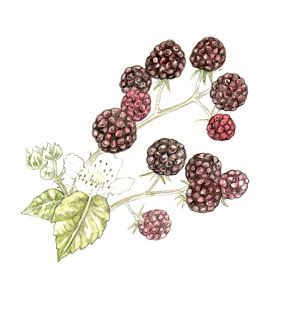 It's the season to be think about picking blackberries for jam and also I'm going to make some blackberry wine this yearI made elderflower champagne in the spring and that was success, even though one of the bottles did explode!
It's the season to be think about picking blackberries for jam and also I'm going to make some blackberry wine this yearI made elderflower champagne in the spring and that was success, even though one of the bottles did explode!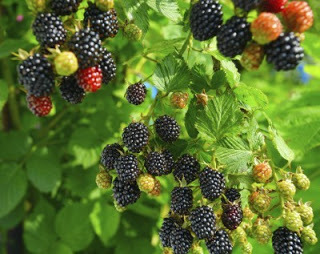
The Blackberry bush is an amazing plant and has many uses apart from making jam and of course wine.It's a common native shrub found throughout Britain. Can climb up to 15ft- 5m, the stems will root where they touch the ground. There are hundreds of micro species in the bramble family. Flowers vary from white to cerise appearing from May to September. The fruit is a cluster of segments called dropelets and appear in the autumn months and may be seen at the same time as the flowers.
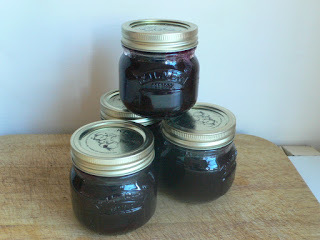
My Jam!
Apart from making jam and wine the plant has a few other uses as well.
Bramble leaves can be used with a healing spell for the treatment of burns: dip nine leaves in running water and lay them on the affected area, say to each leaf as you apply it ‘Three ladies came from the east, one with fire and two with frost, out with fire and in with frost’Or alternatively bruise a handful of fresh leaves and apply to the burn. This can be used for piles, skin ulcers and eczema as well.A decoction of the leaves can be used for sore throats and if you would like a natural mouth wash it can also be used for this.The juice of the berries mixed with the juice of mulberries binds the stomach in cases of diarrhoea, helps sores and ulcers and is good for piles.The leaves boiled in lye and used to wash the scalp relieves an itchy scalp and makes the hair black.
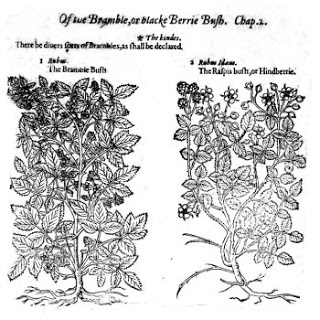
Bramble Leaf TeaThe shoots and young leaves are packed with vitamins and minerals and are ideal for use in a tea, either fresh or dried can be used. Place three or four leaves in a teapot and pour on boiling water, leave to steep for about 15 minutes. Strain then drink. This can be taken as needed; if using to treat diarrhoea make the tea twice the strength and take one cup every hour.Good for mouth ulcers and gum disease, also helpful if you have a cold.
Chewing the leaves will help headaches while crushed leaves can be used to treat small wounds and sores.
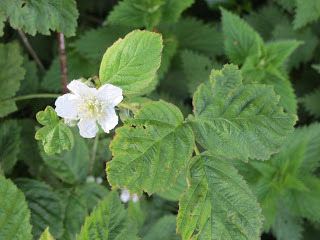
Published on September 15, 2017 06:01
September 11, 2017
Wild Dartmoor
Dartmoor, a place of mystery, made famous by Arthur Conan Doyle's'Hound of the Baskervilles', said to have been inspired by the local legendsof the Yeth Hounds that hunted across these windswept moors.

Wistmans Wood on Dartmoor is the last remains of an ancient woodland and is the home of these hounds. They are a fiercesome sight, jet black, with smoke and flames snorting from their nostrils.From the centre of the woods they start their wild hunt along with a demonic huntsman called Dewer, they race across the wild moorland looking for lost souls.They head for Dewer Stone near Bickleigh where they disappear.If any mortal is unlucky enough to see them it means banishment to a distant land, and speech with the Huntsman means death.
One well known local legend illustrates thedanger of encountering the hounds and huntsman known as Dewer.A local farmer had been visiting the fair at Widecombe and after spending a few hours inthe local tavern decided it was time to set off for home.Staggering along the lonely road across themoor he came across the Hounds and Huntsman.Too drunk to feel afraid he demanded some game from the shadowy figure.With a cold laugh the Huntsman tossed to theman’s feet a bulging sack.It was too dark a night to examine the contents, so he swung it to his shoulder and carried it home.When he got inside he started to open the sackon the kitchen table as he told his wife of his encounter with the dreaded Huntsman.She was just marveling on his lucky escape whenthe dead body of his eldest son fell out of the sack.
Crocken Moor, a rocky granite outcrop which is believed to be the centre of Dartmoor.The guardian spirit of the moor, Old Crocken, rides out from here on a skeleton horse. On dark and stormy nights he rides to Wistmans Wood and releases the hounds and Dewer to hunt lonely travelers.Any meeting with him forebodes bad luck.
‘The gurt old spirit of the moors, Old Crocken himself, grey as granite, and his eyebrows hanging down over his glimmering eyes like sedge, and his eyes as deep as peat water pools.’Sabine Baring Gould 1899
Dartmoor is supposed to have a temperate climate but having visited this area many times once you step onto the moor you enter a different world; not just at risk from the weather but also from the danger of being pixy led.The moor takes its name from the River Dart which starts at East Dart and West Dart then becomes a single river at Dartmeet. It leaves the moor at Buckfastleigh then reaches the sea at Dartmouth
This area has the largest concentration of early Bronze age remains in Britain. During this period the weather was warmer and the moor heavily wooded so it would not seem as inhospitable as it does today.The trees were cleared by the early settlers who established the first farming settlements.There is still evidence of their occupation near Haytor.The fields that these early settlers cultivated covered an area of approx 39 sq miles, the division of the fields called 'reaves' ( banks of earth and stone) are still clearly visible in some areas.
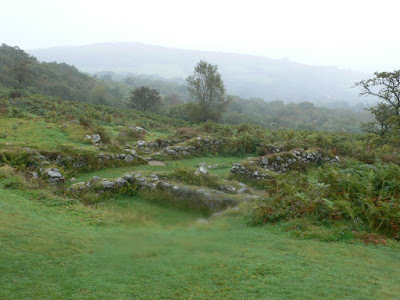
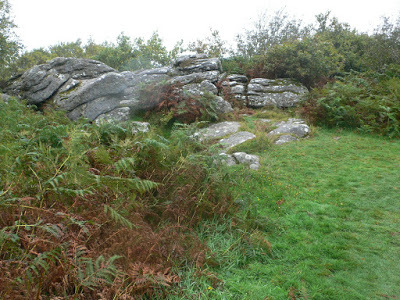
Down into the woods where pixies and headless horsemen and the wish hounds roam...
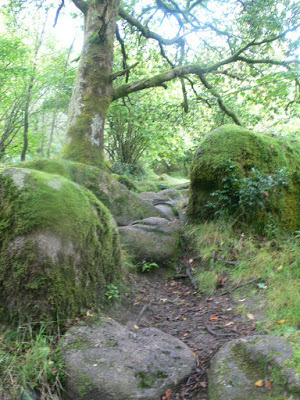
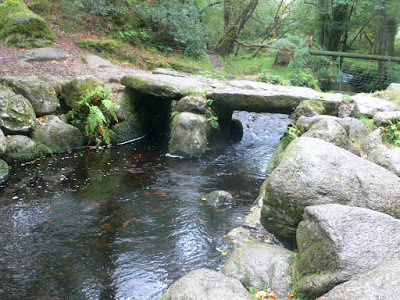
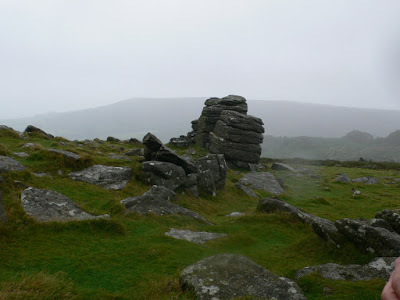
Put your ear to the sides of Tors and you will hear the pixies knocking deep within the rock, or if you are really lucky you will be able to hear the bells being rung in their underground villages.
Published on September 11, 2017 09:29
September 7, 2017
Autumn Harvests
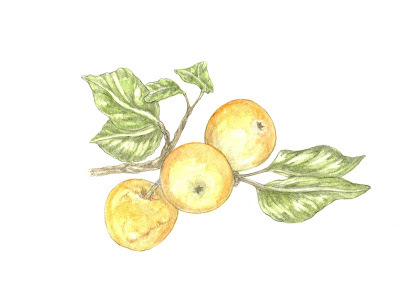
The apple symbolises fruitfulness, prosperity, and rejuvenation and the wood is still seen as a symbol of security. Beware of entering an apple orchard as the trees are inhabited by faeries and pixies, so do not sit beneath a tree and fall asleep or you will fall under a faerie enchantment. If you wish to call upon the faeries summon them with a apple wood wand; and eating an enchanted apple will allow you to enter the faerie realm.
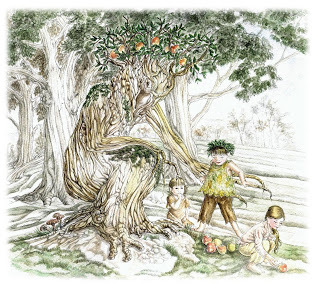
The oldest tree in the orchard is inhabited by the Apple Tree Man, who is the guardian of the orchard. To honour him the last few apples must be left for him and the pixies; this custom is called griggling, pixy hoarding and cullpixying.
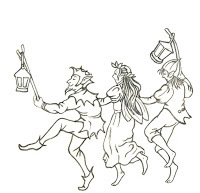
The apple symbolises fruitfulness so barren women would roll on the ground in orchards in an effort to conceive, they also believed that wearing pieces of bark pinned to their clothes would bring them a child, and if it was good year for apples then they could expect to have twins.
The main tradition of the orchard is the custom of wassailing the apple trees during the winter months. This is still prevalent today and has been revived in many country areas.
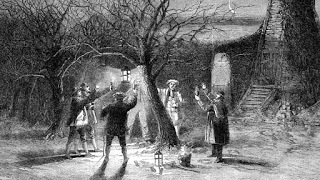
The owner of the orchard, along with friends, gather in the orchard singing, firing shotguns into the branches and beating the trunks with sticks to drive out the evil spirits to ensure a good crop for the coming year.Cider is drunk from the wassailing bowl which contains hot spiced cider, lumps of apple and pieces of toast.The remains from the bowl is poured over the roots as an offering to the Apple Tree Man, and the cider soaked toast is placed in the forks of the trees.
‘Old Apple Tree we wassail thee, and happily thou wilt bear,For the Lord knows where we shall be,Till apples another year’
Published on September 07, 2017 08:26
August 29, 2017
How to make a Witches Ladder

Witches Ladders have been in use for hundreds of years though not many examples remain from that time. One such ladder can be viewed in the Pitt Rivers Museum in Oxford. This is a long length of knotted cord with different coloured feathers woven through out its length, its use would have been to cast spells and more often than not used for a death spell.But they can be used for a more benign purpose; the following spell using a Witches Ladder is for protection, abundance and happiness. Much nicer!
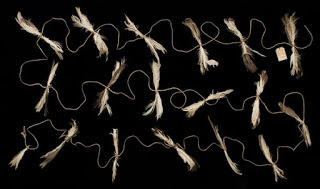
You will need 3 lengths of cord or string or even thread, ( blue for protection) each approx three feet in length.Beads, feathers or some small charms or amulets.
Taking the three lengths tie them together at one end. As you begin to plait them together concentrate your intent and will onto the forming braid beneath your fingers. At any place that you feel the need make a knot and work a bead, feather or charm into the plait, at all times keeping the intent of the spell in your mind. As you create each knot chant the following:“By knot of One, the Spell’s begun, by knot of Two, the Magic comes true, by knot of Three, so it shall be, by knot of Four, this Power is Stored, by knot of Five, my Will shall drive, by knot of Six, the spell I fix, by knot of Seven, the future I leaven, by knot of Eight, my will be fate, by knot of Nine, what is done is mine.”
Then you can hang the Witches Ladder where needed.
Witches Ladders were often bought by sailors for protection whilst at sea. The sailors also believed that the witches bound up the wind inside the knots and when needed if a knot was released the wind could be summoned to aid the ship in its journey.
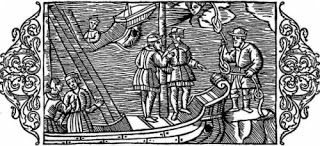
In Italy they have a similar tradition but here it is called a“witches garland”, made of cord, and would have contained black hen feathers. The malediction was uttered as each knot was tied in and the item was placed under the victim's bed. The cord would have had some of the victims hair braided into it along with feathers plucked from a live black hen. The curse could be lifted by finding the wreath and the hen and throwing them into running water. The victim is then taken into the church while they are bathed in Holy water while reciting a spell.
This is a good Witches Ladder for Healing:Take an eight inch length of cord or string, divide it into seven equal parts. And mark the cord so at each mark you tie a knot and repeat the following six times.
“Disease, no one asks you to stay,It’s time for you to fade,With these knots I ask your leaveWith these words I weave.”
Once finished place the knotted cord along with some salt into a container and seal the top with the above spell written on a piece of paper. Then bury the container, as close as possible beneath an Ash tree which is associated with healing. Be careful not to damage the tree whilst doing so!
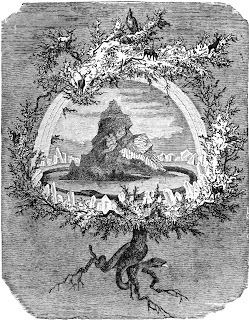
Published on August 29, 2017 08:16
August 16, 2017
Fairy Fun in Burley
The New Forest Fairy Festival 2017Burley Hampshire
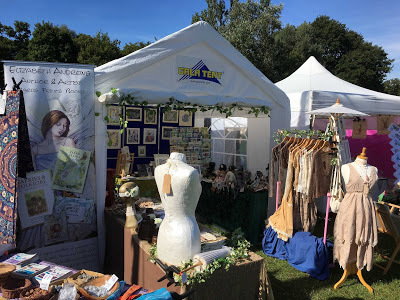 A World of Magic Myth and Legend stall at the Fairy Festival. This year we were joined by 'The Ivory Dolls' showcasing the new range of unique one off dresses and shrugs plus accessories.
A World of Magic Myth and Legend stall at the Fairy Festival. This year we were joined by 'The Ivory Dolls' showcasing the new range of unique one off dresses and shrugs plus accessories.
 The queue started 7.30 in the morning for the grand opening at ten o clock.
The queue started 7.30 in the morning for the grand opening at ten o clock.



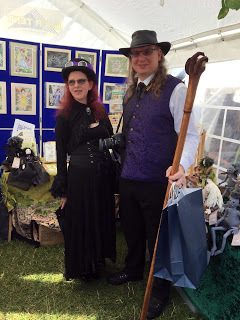 Just some of the amazing costumes sported by our visitors!A great weekend again!
Just some of the amazing costumes sported by our visitors!A great weekend again!
 A World of Magic Myth and Legend stall at the Fairy Festival. This year we were joined by 'The Ivory Dolls' showcasing the new range of unique one off dresses and shrugs plus accessories.
A World of Magic Myth and Legend stall at the Fairy Festival. This year we were joined by 'The Ivory Dolls' showcasing the new range of unique one off dresses and shrugs plus accessories. The queue started 7.30 in the morning for the grand opening at ten o clock.
The queue started 7.30 in the morning for the grand opening at ten o clock.



 Just some of the amazing costumes sported by our visitors!A great weekend again!
Just some of the amazing costumes sported by our visitors!A great weekend again!
Published on August 16, 2017 00:22



